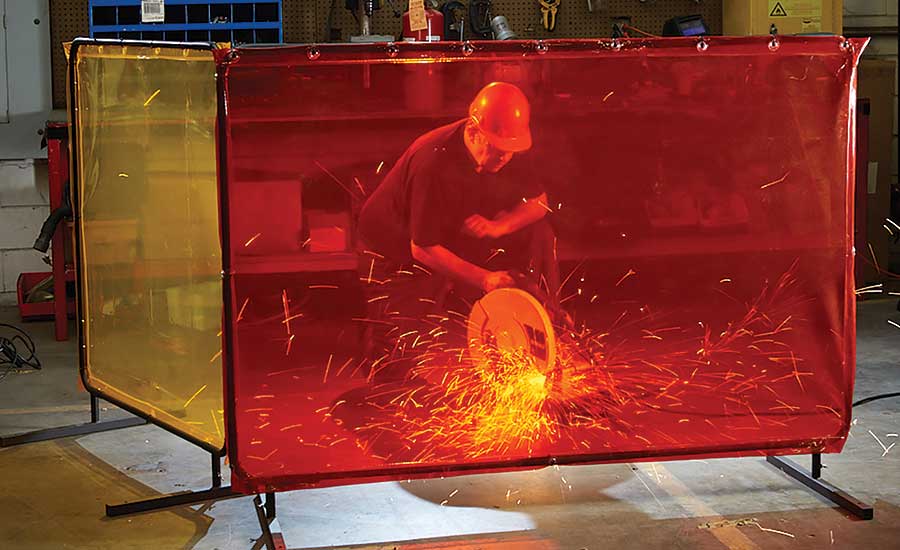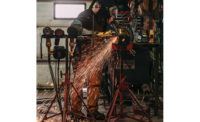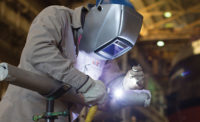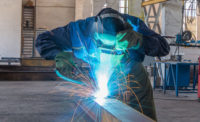Welders are generally well-versed in the face shields, ear plugs, respirators and protective clothing required by 29 CFR 1910, but the guards and barricades also required by this standard are often misunderstood and underutilized. OSHA (1910.252(a)(1)(ii) and 1910.335(b)(2)) recommends them, as does AWS/ANSI Z49.1:2012, so it is important to understand how and when to use these critical pieces of PPE.
There are four common types of guards and barricades that welders will encounter.
- Screens — Constructed of a flexible fabric within a rectangular frame, screens are freestanding on supports or casters. Fabrics options include translucent PVC, cotton or fiberglass. Lightweight versions are easy to assemble on-site and deploy as needed, while heavy-duty versions are ideal for permanent installations. Screens are normally used to protect smaller areas, although multiple screens can be employed together.
- Curtains — Curtains are most often hung from hooks or tracks secured to the ceiling, but can also be hung within a frame for portability. Curtain materials include cotton canvas, fiberglass, polyester and PVC, either in large sheets that can be opened and closed as needed, or from individual strips that allow access at any point. Curtains can protect any size area, but are ideal for larger spaces.
- Enclosures — Enclosures use a modular framing system to create a “room” around the welding area. Walls of the enclosure can be flexible canvas, polyester or PVC, or rigid wood, plastic or aluminum. Ceilings can be added to provide lighting, air filtration and forced ventilation. Enclosures offer a greater level of isolation, security and containment for small to medium sized protection.
- Blankets — Blankets are constructed from heavy-duty and fireproof materials such as cotton duck, cowhides, fiberglass, felts and silicates. Blankets are most commonly laid over equipment and surfaces to add protection, but many are equipped with grommets to allow them to be hung from walls or frames as well.
Restrict access with PPE barriers
The best way to prevent injuries from welding operations is to avoid contact in the first place. This is not always possible on a busy construction site, or when working in areas that must remain accessible. Even in a controlled environment, injuries have been reported from weld flash coming from the side of neighboring welders. PPE barriers are an easy and effective way to protect others by keeping them at a safe distance.
Freestanding welding screens can be used to block and direct foot traffic away from potential welding hazards and to establish a safe perimeter around automated welding equipment and welding gas tanks. Screens are also an ideal solution for temporarily closing off rooms or confined spaces where welding is to occur. Especially in bright yellow or red, welding screens provide a clear visual reminder and physical barrier to keep the uninitiated away.
Curtains can be used to surround a welding area or piece of welding equipment, including robotic welding operations. When closed, the curtain indicates that the welding operation is active and access is restricted. When retracted, everyone knows it is safe to enter the area.
For more severe hazards or increased security concerns, modular enclosures provide a rigid structure with locking doors to prevent unauthorized access. Enclosures can serve as a temporary structure around a repair site or a permanent “room within a room” to create compartmentalized welding stations.
Isolate and contain with PPE shields
Dangerous welding activities are best performed away from people and flammable materials, so moving work to a safe area should always be the top priority. When relocation is not an option, the work area should be policed to remove all combustible items and cleaned to remove any additional fire or hazards. There are times however when welding simply must take place in a hazardous area or in proximity to combustible materials.
In these situation, a welder who focuses only on the PPE that they wear and ignores the impact that their sparks and slag will have on their surroundings, puts themselves at risk of injury from fire, explosion or asphyxiation. Cases have been reported where sparks set fire to nearby sawdust or cardboard boxes, or worse, caused an explosion from powdered chemicals and empty oil drums. It is important to consider what is beyond the immediate area as well. Can slag and sparks penetrate holes or grates and create safety issues elsewhere? Can heat generated by the welding process sufficiently increase the temperature of metal walls or floors to cause ignition on the other side?
PPE shields should be placed around the work area to contain sparks and slag. Blankets should be used to cover and protect machinery, equipment, supplies and building surfaces. Enclosures should be used to completely contain cast-off and gasses that are used. PPE Shields greatly reduces the risk of a fire or explosion that could injure the welder.
Welding, grinding and cutting operations have the added danger of eye injuries from weld flash and cast-off debris. PPE Shields made from solid materials provide maximum light-blocking properties, but also create a dark work area for the welder and prevent visibility of the welding operation. For this reason, most welding screens, curtains and enclosures use translucent, flexible PVC that complies with AWS/ANSI Z49.1:2012 for light transmission.
When welding professionals employ screens, curtains, enclosures and blankets, they not only increase safety for themselves, they help to protect everyone and everything around them. We can’t always control what or where we weld, but we can always protect our environment and keep it safe.



